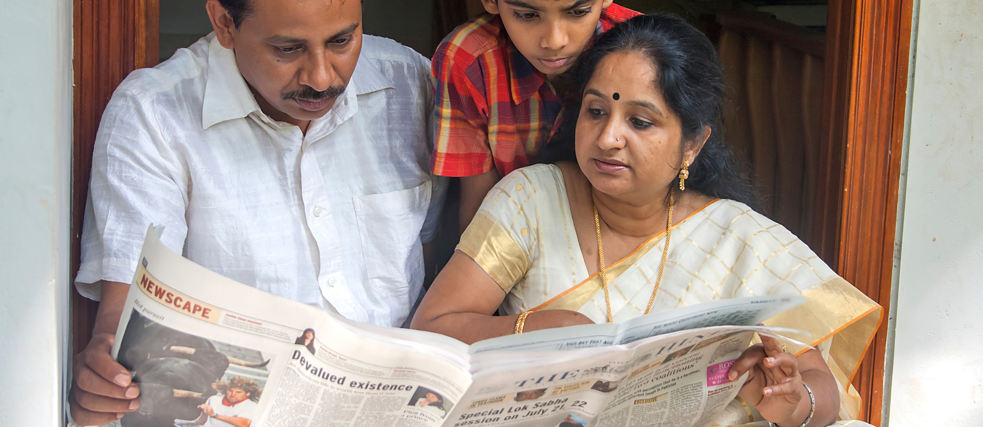Economic situation
Mapping Indian Newspapers

The profession of journalism is beset by several political, social, and economic challenges. But it is these challenges that force newspapers and journalists to discover news in order to not only survive but also thrive and prosper.
By Uttaran Das Gupta
Amit Sen, a 43-year-old photojournalist based out of Kolkata, a metropolitan city in east India, suddenly found himself out of work in late-2019. He had been an employee of Hindustan Times (HT) for four years. “This was my second stint at the HT,” said Sen. “I had first joined it in 2009, right after the Global Recession. I worked for five years before moving on to the Daily News Analysis (DNA).” On returning to HT, he worked for a while in Bengaluru in south India, before moving back to Kolkata. Now, he is a freelancer.
What happened to Sen was not an anomaly. HT, the third largest English newspaper in the country with a circulation of 945,221 as of June 2019 has laid off several journalists since 2017 and shut down several editions, as part of a cost-optimisation plan. Other large newspapers have also followed suit, take for example the DNA, which pulled off its Mumbai and Ahmedabad editions in October last year.
Not cost-covering
In the Indian financial year 2018-19, the total revenue of the national newspaper industry was about €3.9 million (Rs 321 billion), a growth of about five per cent over the previous year’s revenue. A newspaper in India is available for some Euro cents. This, of course, makes newspapers very affordable, but makes revenue generation a major challenge. “For years, newspapers have been extremely reluctant to charge readers a higher price for their daily read despite rising costs. Newspapers make a marginal loss on every copy sold because the reader pays less — way less — than what it costs to produce, print, and deliver each copy. The deficit is made up by advertising,” wrote Divya Guha, senior journalist with the news website The Wire.There are other problems as well.
The World Press Freedom Index, published by Reporters Without Borders (RSF) in April 2020, ranked India at 142 — two places lower than in 2019. In their report, RSF wrote: “With no murders of journalists in India in 2019, as against six in 2018, the security situation for the country’s media might seem, on the face of it, to have improved. However, there have been constant press freedom violations, including police violence against journalists, ambushes by political activists, and reprisals instigated by criminal groups or corrupt local officials.”
These reprisals have at times resulted in tragedy.
September 5, 2017 was a black day for Indian journalism when Gauri Lankesh, the editor of Kannada newspaper Lankesh Patrike, was shot dead outside her house in Bengaluru. Her paper had been deeply critical of Prime Minister Narendra Modi’s government and the ruling Bharatiya Janata Party’s Hindu majoritarian ideology.
But, journalism in India has always faced significant challenges—since its inception in the 18th century—and has always found a way to not only survive, but also thrive."
Uttaran Das Gupta
Times of censorship
Post-independence, the most challenging time for Indian journalism was during the internal Emergency imposed by former Prime Minister Indira Gandhi between 1975 and 1977. When it became evident that newspapers would have to get a clearance from government censors, most media houses agreed except a few. Most notably, The Indian Express and The Statesman decided to publish blank columns as opposed to government-sanctioned news.Despite the pressures, as highlighted by the RSF, Indian newspapers have continued to publish well-researched, deeply investigative pieces, often critical of the government. For instance, in 2019, N Ram, the former editor of The Hindu, published a series of reports highlighting possible corruption in the government’s multi-billion-dollar bid to purchase fighter jets from French company Rafale. Around the same time, Business Standard broke the story of a suppressed government report on how its policies, especially the controversial demonetisation of high-value currency notes in late-2016 led to widespread unemployment.
When it comes to language, English publications form a rather small part of India’s newspaper landscape. Since most Indians like to read news in their own languages, vernacular publications form a significant part of India’s newspaper industry with a total of 121 languages in India, which are spoken by more than 10,000 people.
According to data available on statista.com, there are 105,443 registered newspapers in the country. The most read publication is the Hindi daily, Dainik Bhaskar, with a readership of 4.57 million as of January-June 2019, according to data by the Audit Bureau of Circulation. It registered a growth of 5.8 per cent over its circulation of 4.32 million in the previous half-year period.
The profession of journalism is beset by several political, social, and economic challenges. But it is these challenges that force newspapers and journalists to discover news in order to not only survive but also thrive and prosper.

